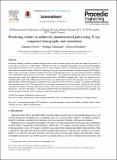| dc.contributor.author | Reinhart, Christoph | |
| dc.date.accessioned | 2020-08-17T15:32:17Z | |
| dc.date.available | 2020-08-17T15:32:17Z | |
| dc.date.issued | 2018-01 | |
| dc.identifier.issn | 1877-7058 | |
| dc.identifier.uri | https://hdl.handle.net/1721.1/126618 | |
| dc.description.abstract | In casting, molding, or additive manufacturing processes, there are some typical issues that can change the geometry of a part and cause porosity or other defects. With the aid of X-ray computed tomography (CT), internal discontinuities and geometry deviations can be accurately detected and visualized. However, the question remains in how far a given defect affects mechanical failure. We aim at bridging this gap by structural mechanics simulations based on CT images. In this study, we describe a method to predict the tensile strength and the location of crack initiation from the simulated stress distributions on the basis of local stress concentrations. We validate the method for tensile rods and real-life aeronautic parts which were additively manufactured from an AlSi10Mg aluminum alloy. Thirty-six specimens were manufactured in total, where different porosity patterns were deliberately inserted. The specimens were CT-scanned in high resolution. Structural mechanics simulations were carried out on basis of the CT images. An immersed-boundary finite elements code is used. The generation of a conforming simulation mesh is not required, making the code suitable especially for complex geometries like porous objects. The same test specimens were subjected to destructive physical tensile tests. We show that there is a very good correlation between the predicted and measured tensile strengths, and that the location of the first crack occurrence can be forecasted accurately. | en_US |
| dc.language.iso | en | |
| dc.publisher | Elsevier BV | en_US |
| dc.relation.isversionof | 10.1016/j.proeng.2018.02.008 | en_US |
| dc.rights | Creative Commons Attribution-NonCommercial-NoDerivs License | en_US |
| dc.rights.uri | http://creativecommons.org/licenses/by-nc-nd/4.0/ | en_US |
| dc.source | Elsevier | en_US |
| dc.title | Predicting failure in additively manufactured parts using X-ray computed tomography and simulation | en_US |
| dc.type | Article | en_US |
| dc.identifier.citation | Fieresa, Johannes, Philipp Schumannb and Christof Reinhart. “Predicting failure in additively manufactured parts using X-ray computed tomography and simulation.” Procedia engineering, vol. 213, 2018, pp. 69-78 © 2018 The Author(s) | en_US |
| dc.contributor.department | Massachusetts Institute of Technology. Department of Architecture | en_US |
| dc.relation.journal | Procedia engineering | en_US |
| dc.eprint.version | Final published version | en_US |
| dc.type.uri | http://purl.org/eprint/type/JournalArticle | en_US |
| eprint.status | http://purl.org/eprint/status/PeerReviewed | en_US |
| dc.date.updated | 2019-08-08T14:37:22Z | |
| dspace.date.submission | 2019-08-08T14:37:24Z | |
| mit.journal.volume | 213 | en_US |
| mit.metadata.status | Complete | |
